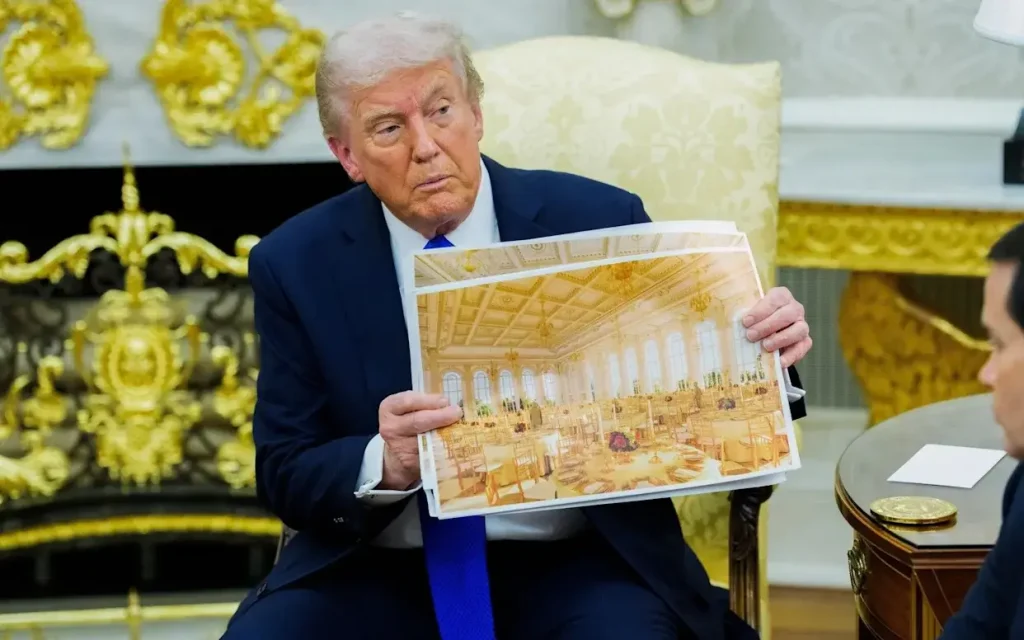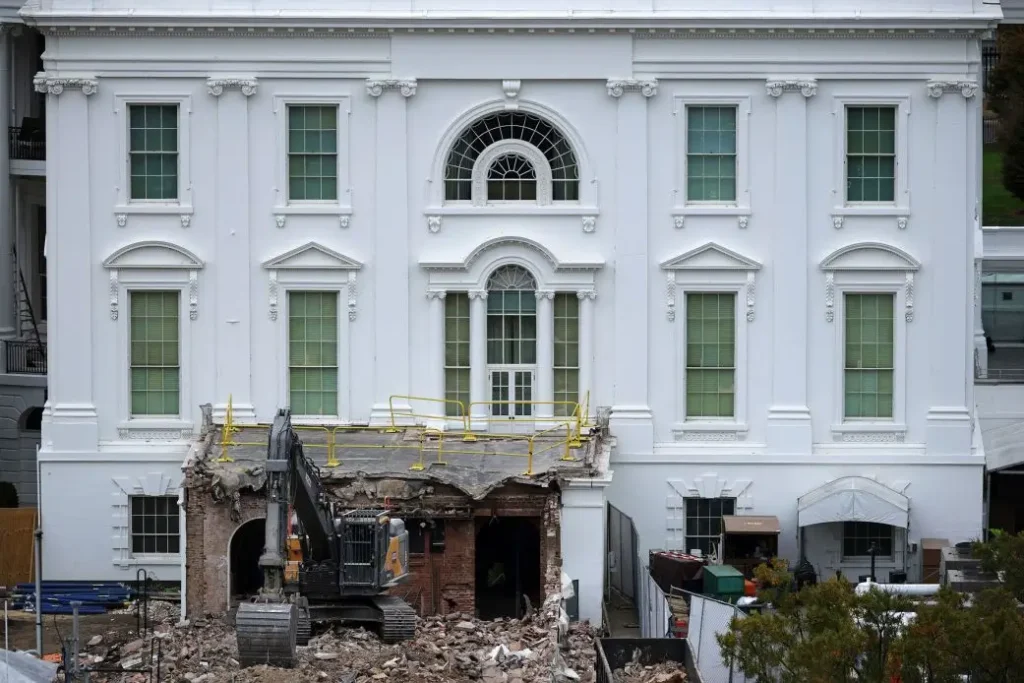The White House has dismissed the entire U.S. Commission of Fine Arts, the independent body responsible for advising on design and aesthetics in the nation’s capital. The move follows President Donald Trump’s proposal to build a $300 million ballroom at the White House — a project critics say raises ethical, architectural, and governance concerns.

Table of Contents
Trump’s $300 Million Ballroom Controversy
| Key Fact | Detail |
|---|---|
| Fired Officials | Six members of the Commission of Fine Arts (CFA) removed |
| Main Project | $300 million ballroom replacing part of the East Wing |
| Funding | Privately financed through donors; no taxpayer funds, per White House |
| Oversight Concerns | Firing removes independent design review during project debate |
The Firings and Their Timing
The firings were confirmed late on October 28, when members of the Commission of Fine Arts (CFA) received official termination letters stating their appointments were “ended effective immediately.” The CFA, established by Congress in 1910, traditionally advises presidents, Congress, and federal agencies on the architectural integrity of national landmarks, including the White House, the National Mall, and other historic properties.
According to The Washington Post, the move came shortly before the CFA was scheduled to review Trump’s ambitious proposal to construct a 90,000-square-foot ballroom and reception hall adjoining the East Wing — a plan with an estimated cost of $300 million.
The project, already facing scrutiny from preservationists, would mark the largest physical expansion of the White House since the Truman-era reconstruction in the 1950s. A White House spokesperson said new members would be appointed “to reflect the administration’s commitment to classical American architecture and efficient project delivery.”

The $300 Million Ballroom: A Presidential Vision
President Trump’s ballroom proposal envisions a multi-purpose hall capable of hosting state dinners, diplomatic events, and large-scale ceremonies. The White House has said the initiative is meant to “modernize and beautify” the executive residence, which it argues is undersized for the current scale of official gatherings.
“This will be a private, world-class facility showcasing the best of American design,” a senior White House official told Reuters. “It will not cost taxpayers a dime.”
Architectural renderings obtained by The Guardian show a neoclassical façade and domed roof inspired by early 20th-century American Beaux-Arts style. Critics, however, warn that the design could disrupt the architectural harmony of the White House complex.
Historical Context: White House Changes Through the Ages
Major White House modifications have historically been rare and heavily scrutinized. President Theodore Roosevelt expanded the executive offices in 1902. President Harry S. Truman oversaw a structural overhaul in 1948 after engineers declared the building unsafe. More recently, smaller updates — such as President Obama’s kitchen modernization — cost roughly $12 million.
Unlike past renovations, Trump’s proposal is aesthetic and functional, not structural. Preservation experts note that previous expansions prioritized safety or efficiency, while the ballroom aims to enhance ceremonial prestige.
“The Truman reconstruction saved the building from collapse,” said Dr. Allen Speer, a historian at George Washington University. “The Trump project appears designed to reshape its symbolism — to leave an architectural legacy.”
Reaction from Preservationists and Lawmakers
The National Trust for Historic Preservation called the firings “unprecedented” and warned they could erode the independence of federal oversight.
“The Commission of Fine Arts has safeguarded the nation’s cultural and architectural identity for more than a century,” said Trust President Paul Edmonds. “Firing its entire membership during a high-profile project risks politicizing preservation.”
Lawmakers from both parties expressed unease. Democratic Senator Elizabeth Warren demanded a review of donor funding sources, citing concerns about foreign money. Republican Senator Susan Collins said while presidents have the right to appoint advisers, “removing experts mid-project undermines transparency and continuity.”
Legal and Governance Implications
Federal law gives the CFA an advisory — but influential — role in reviewing public designs. Although the President can dismiss members, the timing has prompted questions about executive overreach.
Constitutional scholar Dr. Jane Raskin of Georgetown University said the decision is “technically legal but normatively disruptive.”
“The CFA’s function is consultative,” Raskin said. “But its removal before a major federal project review sends a signal that traditional checks on executive aesthetic decisions are being weakened.”
The Government Accountability Office (GAO) has authority to review the project’s procurement and contracting processes if federal property or funds are involved, even indirectly. Lawmakers have urged GAO to clarify whether private donations to a White House project fall under federal disclosure laws.
The White House Defense
The administration maintains the decision reflects a “reset” rather than a purge. A White House statement said the new CFA members “will embody a vision of American architecture that honors classical design and functional beauty.”
Privately, aides described frustration within the administration over what they view as “delays and bureaucratic obstruction” from the previous commission. The project team includes architects from firms known for neoclassical and revivalist designs — styles favored by Trump’s 2020 executive order, Promoting Beautiful Federal Architecture, which emphasized traditional forms over modernist designs.

Public and Political Reactions
Public reaction has been mixed. Supporters argue that the ballroom could become a symbol of national pride and a space for cultural diplomacy. Critics see it as an exercise in self-promotion.
A poll conducted by Pew Research Center found that 54% of respondents oppose major taxpayer-funded White House expansions, though support rose to 61% when respondents were told the funding would be private.
Social media debate has been fierce, with some conservatives praising the move as “restoring grandeur,” while others question the ethics of dismissing expert advisers to fast-track the project.
Related Links
$1800 Stimulus Checks Set to Arrive Soon for Eligible Residents in This State: Check Details
Trump’s $1,000 Baby Stimulus: How It Could Grow to $93,000 for Your Child
What Happens Next
The White House is expected to announce replacements for the CFA within weeks. New appointees reportedly include designers aligned with Trump’s architectural vision and members of the National Civic Art Society, a conservative advocacy group.
The project must still undergo environmental and security reviews by the National Capital Planning Commission (NCPC) and the Secret Service. Those agencies will determine whether construction can proceed without disrupting security or historical preservation standards. Observers say construction is unlikely to begin before mid-2026, even under an accelerated schedule.
Broader Implications: Architecture and Power
Analysts say the firings highlight a larger trend — the politicization of design governance in Washington. The CFA’s dismissal, they argue, symbolizes the tension between populist politics and professional expertise.
“This isn’t just about architecture,” said Dr. Elaine Kamarck, senior fellow at the Brookings Institution. “It’s about how power manifests in public space — who controls the image of the Republic, and at what cost.”
















